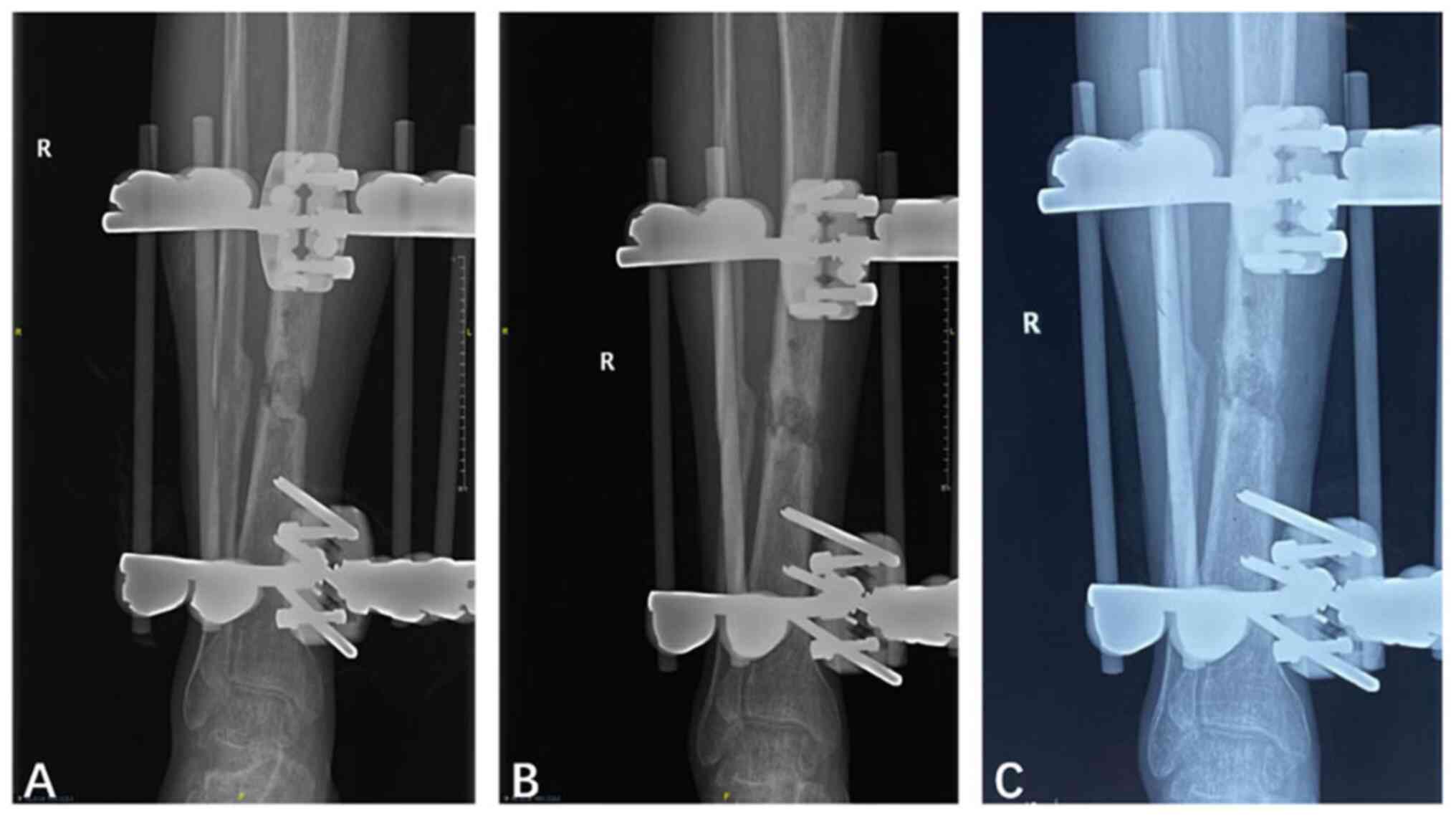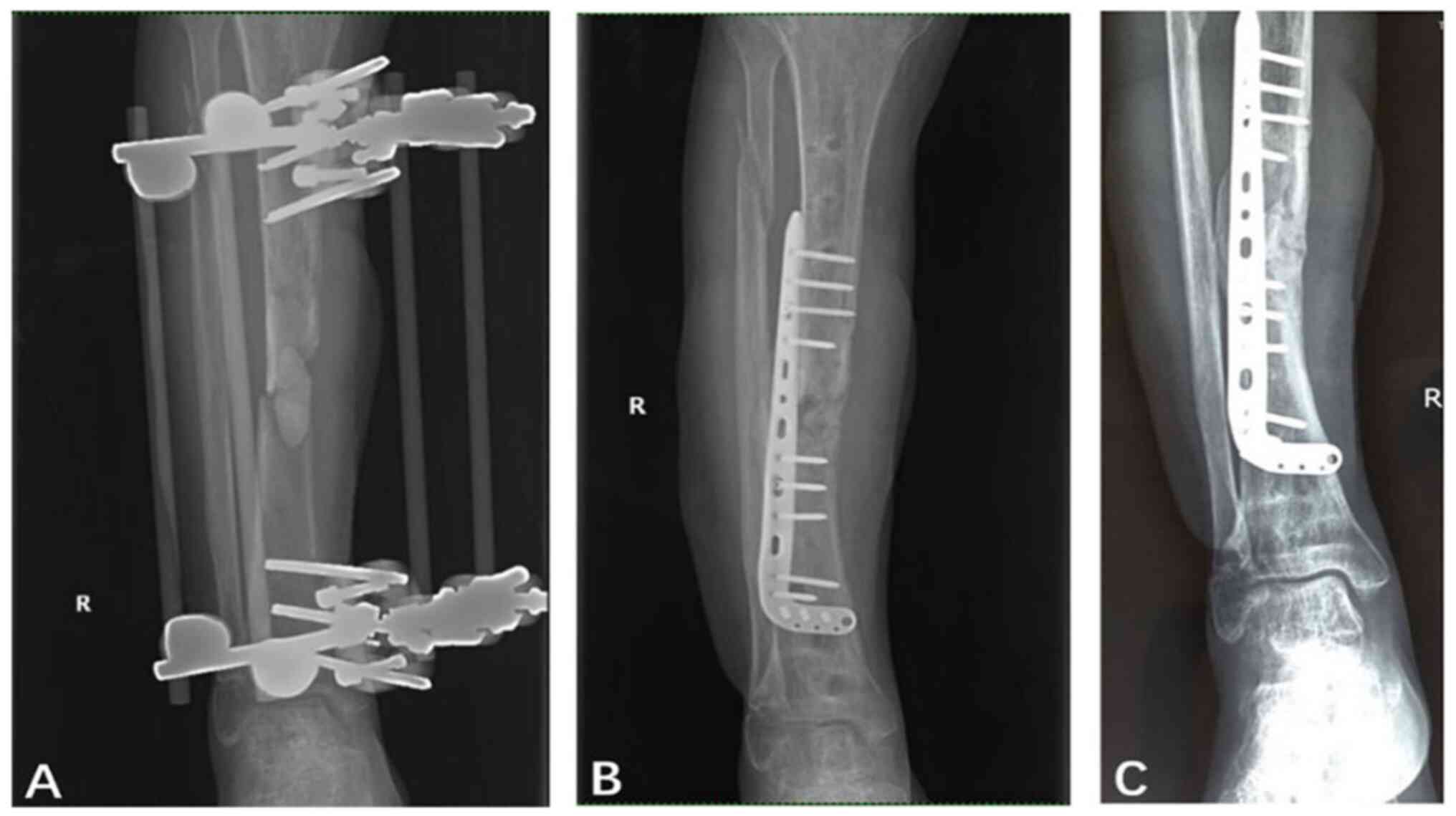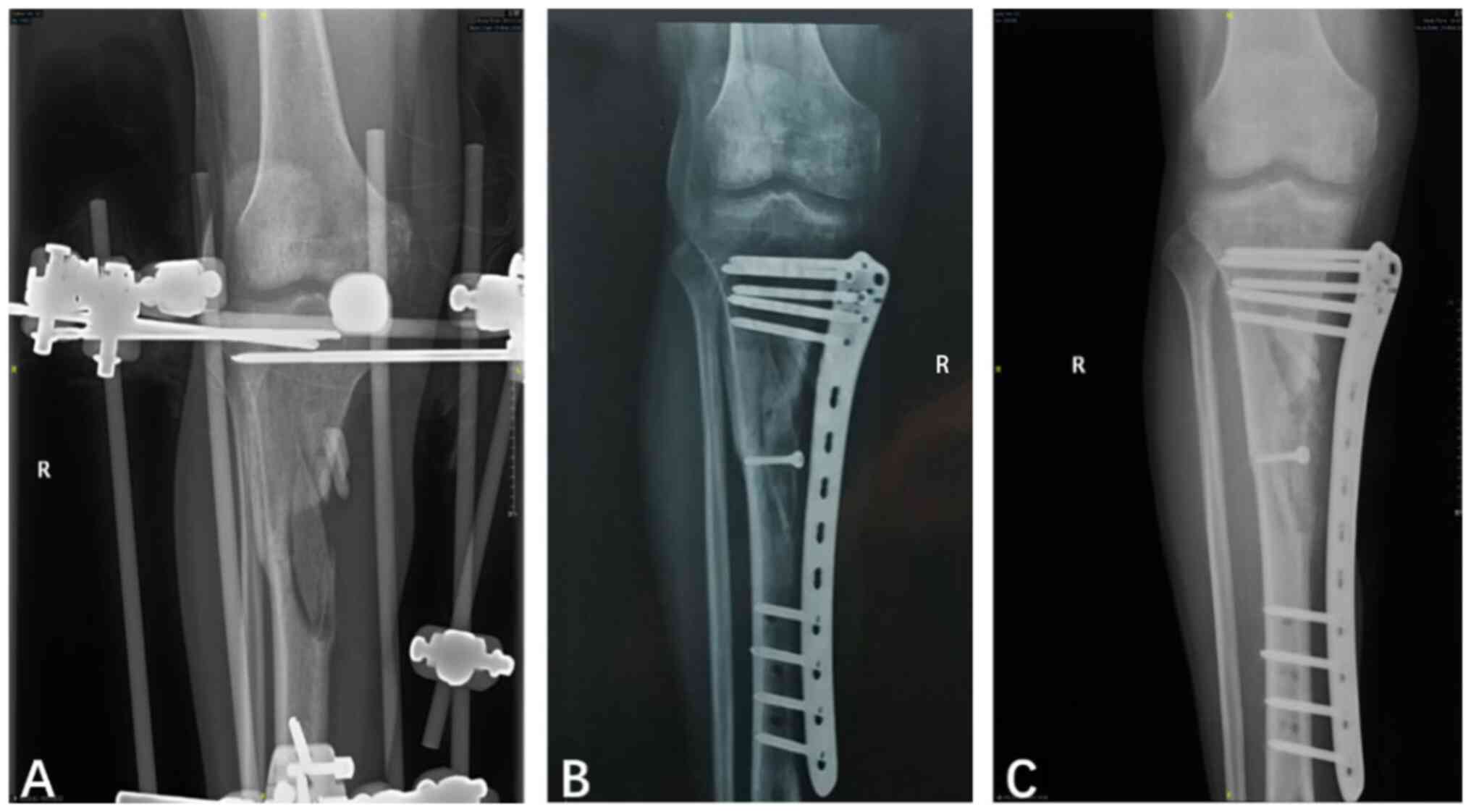|
1
|
Patzakis MJ and Zalavras CG: Chronic
posttraumatic osteomyelitis and infected nonunion of the tibia:
Current management concepts. J Am Acad Orthop Surg. 13:417–427.
2005.PubMed/NCBI View Article : Google Scholar
|
|
2
|
Cierny G and Mader JT: Adult chronic
osteomyelitis. Orthopedics. 7:1557–1564. 1984.PubMed/NCBI View Article : Google Scholar
|
|
3
|
Qin C, Xu L, Liao J, Fang J and Hu Y:
Management of osteomyelitis-induced massive tibial bone defect by
monolateral external fixator combined with antibiotics-impregnated
calcium sulphate: A retrospective study. Biomed Res Int.
2018(9070216)2018.PubMed/NCBI View Article : Google Scholar
|
|
4
|
Feng D, Zhang Y, Jia H, Xu G, Wu W, Yang
F, Ding J, Li D, Wang K, Luo Y, et al: Complications analysis of
Ilizarov bone transport technique in the treatment of tibial bone
defects-a retrospective study of 199 cases. BMC Musculoskelet
Disord. 24(864)2023.PubMed/NCBI View Article : Google Scholar
|
|
5
|
Wang X, Luo F, Huang K and Xie Z: Induced
membrane technique for the treatment of bone defects due to
post-traumatic osteomyelitis. Bone Joint Res. 5:101–105.
2016.PubMed/NCBI View Article : Google Scholar
|
|
6
|
Pesch S, Hanschen M, Greve F, Zyskowski M,
Seidl F, Kirchhoff C, Biberthaler P and Huber-Wagner S: Treatment
of fracture-related infection of the lower extremity with
antibiotic-eluting ceramic bone substitutes: Case series of 35
patients and literature review. Infection. 48:333–344.
2020.PubMed/NCBI View Article : Google Scholar
|
|
7
|
Mathieu L, Tossou-Odjo L, de l'Escalopier
N, Demoures T, Baus A, Brachet M and Masquelet A: Induced membrane
technique with sequential internal fixation: Use of a reinforced
spacer for reconstruction of infected bone defects. Int Orthop.
44:1647–1653. 2020.PubMed/NCBI View Article : Google Scholar
|
|
8
|
Tulner S, Strackee S and Kloen P:
Metaphyseal locking compression plate as an external fixator for
the distal tibia. Int Orthop. 36:1923–1927. 2012.PubMed/NCBI View Article : Google Scholar
|
|
9
|
Blažević D, Kodvanj J, Adamović P, Vidović
D, Trobonjača Z and Sabalić S: Comparison between external locking
plate fixation and conventional external fixation for
extraarticular proximal tibial fractures: A finite element
analysis. J Orthop Surg Res. 17(16)2022.PubMed/NCBI View Article : Google Scholar
|
|
10
|
Cierny G III, Mader JT and Penninck JJ: A
clinical staging system for adult osteomyelitis. Clin Orthop Relat
Res. 7–24. 2003.PubMed/NCBI View Article : Google Scholar
|
|
11
|
Tetsworth K, Burnand H, Hohmann E and
Glatt V: Classification of bone defects: An extension of the
orthopaedic trauma association open fracture classification. J
Orthop Trauma. 35:71–76. 2021.PubMed/NCBI View Article : Google Scholar
|
|
12
|
Kubiak G and Fabiś J: To compare the
results of knee evaluation after meniscus repair and anterior
cruciate ligament reconstruction on the basis of Lysholm, HSS and
IKDC scoring systems. Pol Orthop Traumatol. 77:127–131.
2012.PubMed/NCBI
|
|
13
|
Shazadeh Safavi P, Janney C, Jupiter D,
Kunzler D, Bui R and Panchbhavi V: A systematic review of the
outcome evaluation tools for the foot and ankle. Foot Ankle Spec.
12:461–470. 2019.PubMed/NCBI View Article : Google Scholar
|
|
14
|
Olatunji BO, Deacon BJ, Abramowitz JS and
Tolin DF: Dimensionality of somatic complaints: Factor structure
and psychometric properties of the self-rating anxiety scale. J
Anxiety Disord. 20:543–561. 2006.PubMed/NCBI View Article : Google Scholar
|
|
15
|
Patzakis MJ, Abdollahi K, Sherman R,
Holtom PD and Wilkins J: Treatment of chronic osteomyelitis with
muscle flaps. Orthop Clin North Am. 24:505–509. 1993.PubMed/NCBI
|
|
16
|
Tetsworth K and Cierny G III:
Osteomyelitis debridement techniques. Clin Orthop Relat Res. 87–96.
1999.PubMed/NCBI View Article : Google Scholar
|
|
17
|
Abulaiti A, Yilihamu Y, Yasheng T, Alike Y
and Yusufu A: The psychological impact of external fixation using
the Ilizarov or Orthofix LRS method to treat tibial osteomyelitis
with a bone defect. Injury. 48:2842–2846. 2017.PubMed/NCBI View Article : Google Scholar
|
|
18
|
Marti R and van der Werken C: The AO-plate
for external fixation in 12 cases. Acta Orthop Scand. 62:60–62.
1991.PubMed/NCBI View Article : Google Scholar
|
|
19
|
Apivatthakakul T and Sananpanich K: The
locking compression plate as an external fixator for bone transport
in the treatment of a large distal tibial defect: A case report.
Injury. 38:1318–1325. 2007.PubMed/NCBI View Article : Google Scholar
|
|
20
|
Woon YL, Wong MK and Howe TS: LCP external
fixation-external application of an internal fixator: Two cases and
a review of the literature. J Orthop Surg Res. 5(19)2010.PubMed/NCBI View Article : Google Scholar
|
|
21
|
Parameswaran AD, Roberts CS, Seligson D
and Voor M: Pin tract infection with contemporary external
fixation: How much of a problem? J Orthop Trauma. 17:503–507.
2003.PubMed/NCBI View Article : Google Scholar
|
|
22
|
Stoffel K, Dieter U, Stachowiak G, Gächter
A and Kuster M: Biomechanical testing of the LCP-how can stability
in locked internal fixators be controlled? Injury. 34 (Suppl
2):B11–B19. 2003.PubMed/NCBI View Article : Google Scholar
|
|
23
|
Liu W, Yang L, Kong X, An L, Hong G, Guo Z
and Zang L: Stiffness of the locking compression plate as an
external fixator for treating distal tibial fractures: A
biomechanics study. BMC Musculoskelet Disord. 18(26)2017.PubMed/NCBI View Article : Google Scholar
|
|
24
|
Kanchanomai C and Phiphobmongkol V:
Biomechanical evaluation of fractured tibia externally fixed with
an LCP. J Appl Biomech. 28:587–592. 2012.PubMed/NCBI View Article : Google Scholar
|
|
25
|
Röderer G, Abouelsoud M, Gebhard F,
Böckers TM and Kinzl L: Minimally invasive application of the
non-contact-bridging (NCB) plate to the proximal humerus: An
anatomical study. J Orthop Trauma. 21:621–627. 2007.PubMed/NCBI View Article : Google Scholar
|
|
26
|
Alemdar C, Azboy I, Atiç R, Özkul E, Gem M
and Kapukaya A: Management of infectious fractures with
‘Non-Contact Plate’ (NCP) method. Acta Orthop Belg. 81:523–529.
2015.PubMed/NCBI
|

















